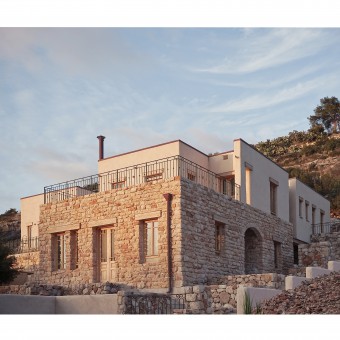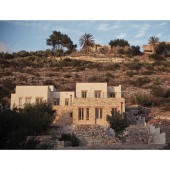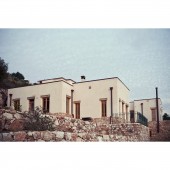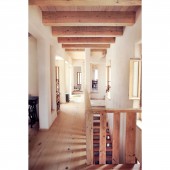Cannabis Walls House by Tav Group |
Home > Winners > #58994 |
 |
|
||||
| DESIGN DETAILS | |||||
| DESIGN NAME: Cannabis Walls PRIMARY FUNCTION: House INSPIRATION: A house could and should be built and lived in as nature would have it, like a bird feathering her nest, treading softly on the earth and leaving the faintest ecological footprint. The steep sloping site served in the past as quarry for the village stone houses, hence the use of the in-situ carved stone as primary building material, along with hemp and lime mixture (hempcrete) walls cast on timber frame. The house's volumes recline on the hillside like a goats herd gliding down the hill, giving ample opportunity for indoor-outdoor intercourse. UNIQUE PROPERTIES / PROJECT DESCRIPTION: A private house made of local, natural, environmentally friendly materials, that blends with the beauty of its natural surroundings and designed to passively provide optimal spatial and climatic conditions year round, featuring ecological infrastructure systems, including greywater purifying and reuse, roof rainwater gathering into an underground cistern, compost toilets, rooftop solar panels and passive air conditioning. OPERATION / FLOW / INTERACTION: The entrance hall opens to the south-west view of the valley and the mediterrenean horizon, bringing in the sea breeze, which is captured on the southern semi-enclosed court, flows across the rooms through the northern upper openings, assuring a year round comfort without artificial air conditioning. This axis serves as a joint between the living quarter to the west and the private quarter to the east, while the perpedicular axis runs east-west and binds all functions together. The northern hillside is stepped back to allow for a service court that also acts as a ventilating wind-well. PROJECT DURATION AND LOCATION: The house is located in Ein Hod artists' village, on the western slopes of Mount Carmel. The project's planning started in august 2009. It took several years to go through the design and bureaucracy processes and actual construction was commenced in late 2014. The house was inhabited in mid 2016. FITS BEST INTO CATEGORY: Architecture, Building and Structure Design |
PRODUCTION / REALIZATION TECHNOLOGY: Ground floor walls are 60 cm thick, made of local stone carved on site while excavating foundations. These stones also served for floor paving and terracing. Upper floor walls are made of "hempcrete" SPECIFICATIONS / TECHNICAL PROPERTIES: 250 square meters house on a lot of approx. 1,000 square meters. TAGS: hemp house, cannabis house, ecological house, architecture, environment, Ein Hod, Tav group RESEARCH ABSTRACT: Much attention was paid to choosing the right building materials and techniques. The owner, an evironmental activist himself, went all the way to the south of France to pick up the know-how for the hempcrete preparation. Many tests were made to assure the best composition for the various members of the construction - interior and exterior walls, ceilings and flooring. Joseph of "Botz" group, who was the contractor of the wall casting, also took part in investigating the material aspect, including rigorous tests done with the help of the Standards Intitution of Israel. CHALLENGE: As the first ever hempcrete house built in Israel, there were many knowledge lacunas to fill, from the right construction system through the composition and application of materials and up to the details of joints and thermal bridges prevention. One of the questionable aspects was how would the authorities react to this innovative construction: would they allow importing the cannabis bales for the walls? Would they accept a house without concrete construction? And how would the fire department see it? (this building method is indeed tenfold safer than standard building. The fireproof hempcrete envelopes the wooden frame and protects it, and in time solidifies into bearing porous limestone walls. ADDED DATE: 2017-07-17 15:15:10 TEAM MEMBERS (6) : Maoz Alon, Yoav Trifon, Dalia Kramer, Amir Erez, Elias Khuri and Naama Sivan IMAGE CREDITS: Image #1: Photographer Gon Alon, South-east perspective view, 2017 Image #2: Photographer Gon Alon, South facade, 2017 Image #3: Photographer Gon Alon, West facade, 2016 Image #4: Photographer Yaeli Gabriely, Interior view: stone walled studio, 2016 Image #5: Photographer Yaeli Gabriely, East-west interior axis, 2016 |
||||
| Visit the following page to learn more: http://www.tavgroup.com/ | |||||
| AWARD DETAILS | |
 |
Cannabis Walls House by Tav Group is Winner in Architecture, Building and Structure Design Category, 2017 - 2018.· Read the interview with designer Tav Group for design Cannabis Walls here.· Press Members: Login or Register to request an exclusive interview with Tav Group. · Click here to register inorder to view the profile and other works by Tav Group. |
| SOCIAL |
| + Add to Likes / Favorites | Send to My Email | Comment | Testimonials | View Press-Release | Press Kit | Translations |
Did you like Tav Group's Architecture Design?
You will most likely enjoy other award winning architecture design as well.
Click here to view more Award Winning Architecture Design.








